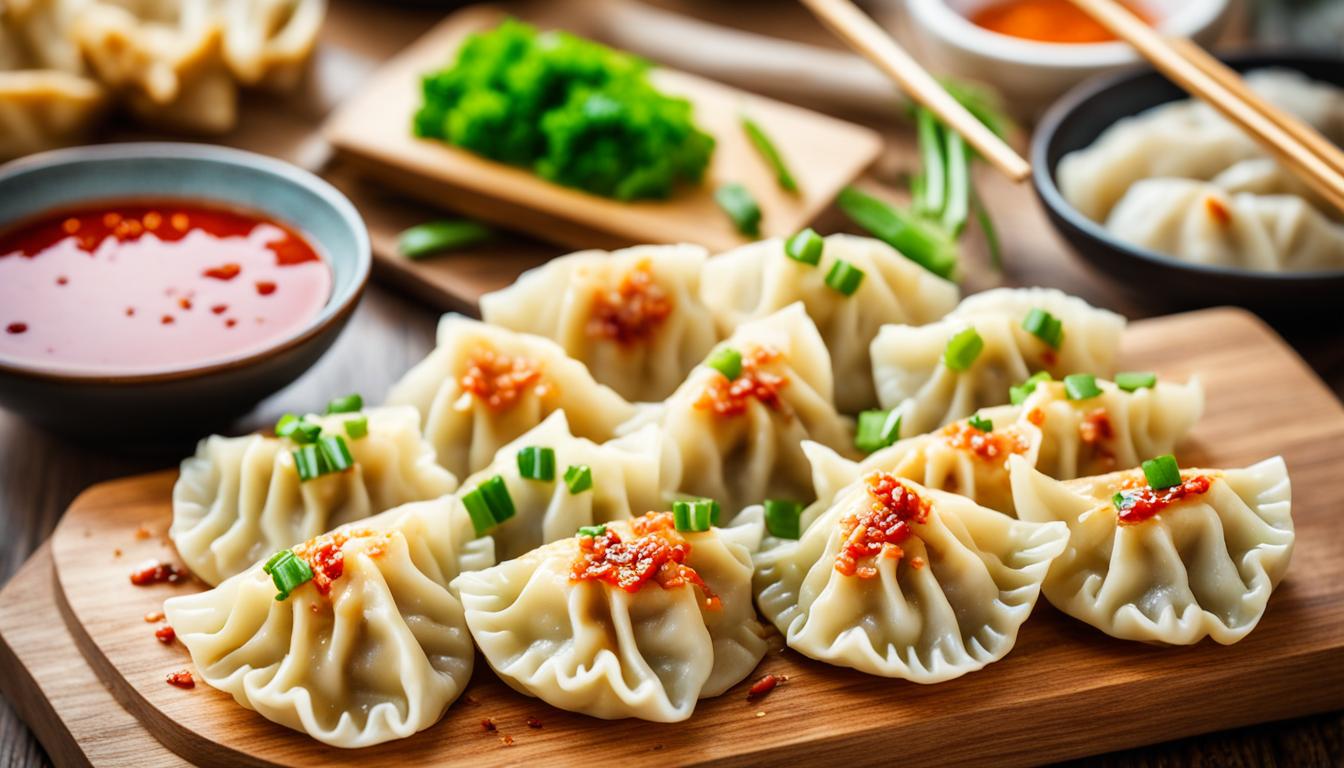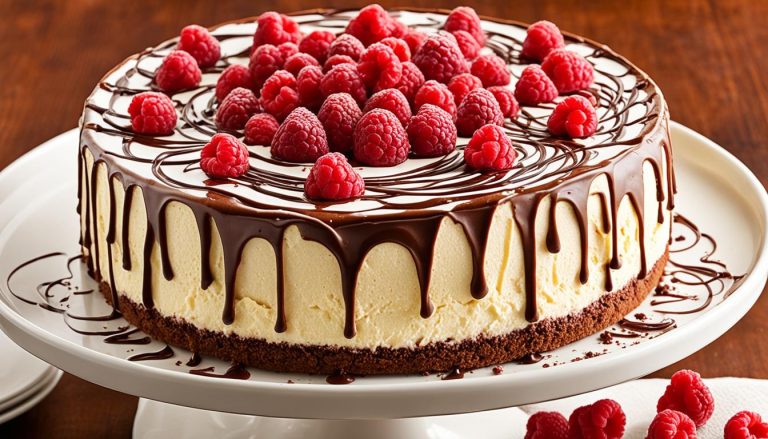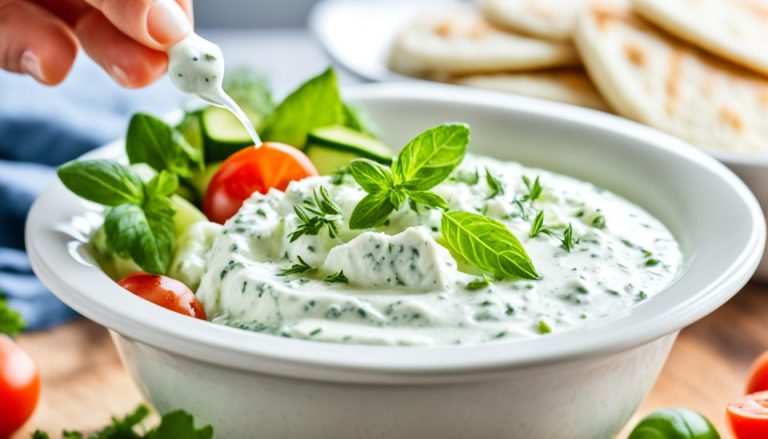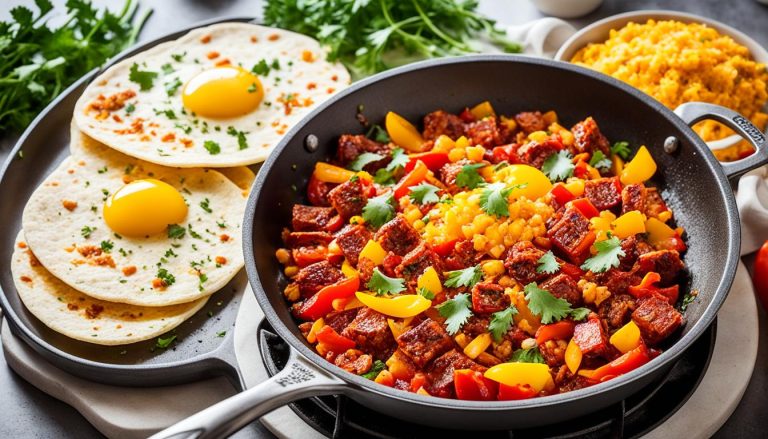As I stand in the kitchen, the familiar aroma of gyoza wafts through the air, instantly transporting me back to my childhood. It was a cherished tradition in our family to gather around the table, rolling and folding these Japanese dumplings together, each one a labour of love. Now, I’m thrilled to share my mother’s authentic gyoza recipe with you, so you can experience the joy of making these delectable homemade gyoza in your own kitchen.
You see, when it comes to Japanese cuisine, my mother is the undisputed master. While the rest of us may know our way around the kitchen, it is her domain, and gyoza is one of her specialities. Every couple of months, our family eagerly requests these juicy, golden-brown dumplings, and even though my siblings and I are capable of making them ourselves, there’s something irreplaceable about the way my mother prepares the gyoza filling and guides us through the gyoza folding process.
I still remember the excitement I felt when my mother mentioned the possibility of starting a Japanese food blog to share all her cherished recipes. The thought of being able to preserve and share these authentic gyoza cooking instructions and techniques fills me with joy, and I can’t wait to see what other delicious dumplings she has in store for us.
What is Gyoza?
Gyoza are Japanese pan-fried dumplings that are crisp and golden on the bottom and juicy inside. They are the Japanese version of the original Chinese dumplings called Jiaozi. The key difference between gyoza and Chinese dumplings (also known as potstickers) is the cooking method – gyoza are first fried in a hot pan until crispy brown on the bottom, then a small amount of water is added before the pan is covered to steam the dumplings quickly. This technique gives gyoza the best mix of textures, with crispy bottoms and tender, soft tops that encase the juicy filling inside.
Gyoza vs Chinese Dumplings
Gyoza also tend to be smaller in size with thinner skin compared to Chinese dumplings, yielding a more crispy texture and bite. The filling in gyoza is typically made with ground pork, whereas Chinese dumplings can use a variety of meats like pork, beef, lamb, chicken, fish, and shrimp.
Key Characteristics of Gyoza
The key characteristics that define gyoza are their pan-fried and steamed cooking method, smaller size, thinner wrapper, and pork-based filling. This combination of techniques and ingredients results in the signature gyoza texture and flavour profile that sets them apart from their Chinese dumpling counterparts.

Ingredients for Homemade Gyoza
Crafting authentic Japanese gyoza at home requires a careful selection of high-quality ingredients. The heart of the dish lies in the filling, which features a delectable blend of ground pork, crisp cabbage, fragrant garlic chives, aromatic garlic and ginger, nutty sesame oil, savoury soy sauce, and just a touch of cornstarch to bind it all together.
Filling Ingredients
Unlike their Chinese dumpling counterparts, gyoza are traditionally made with a filling that showcases the umami-rich flavour of ground pork. The cabbage used in gyoza is typically more robust than the delicate napa cabbage found in Chinese dumplings, requiring a little extra preparation to tenderise the leaves. This can be done by blanching, microwaving, or salting and squeezing out the excess moisture. The addition of fragrant garlic chives (known as nira in Japanese) is an authentic touch, but regular chives or the green part of scallions can also be used if the specialty ingredient is unavailable.
For your easy understanding, the ingredients are,
- 250g ground pork
- 1 cup finely chopped cabbage
- 2 tbsp chopped garlic chives (nira)
- 2 cloves of garlic, minced
- 1-inch piece of ginger, grated
- 1 tbsp sesame oil
- 1 tbsp soy sauce
- 1 tsp cornstarch
Gyoza Wrappers
For the perfect gyoza texture, Japanese-style wrappers are the gold standard. These thin, delicate skins are considerably more refined than the thicker Chinese wonton wrappers, yielding a beautifully crisp exterior that encases the juicy filling. While store-bought gyoza wrappers are a convenient option, making them from scratch at home can be an immensely satisfying experience. A detailed tutorial on crafting homemade gyoza wrappers is provided for those who wish to take their gyoza game to the next level. Vegan versions of gyoza can also be created using a plant-based filling in place of the traditional pork.

Gyoza recipe
The recipe involves three main steps: preparing the filling, folding the gyoza, and cooking them to perfection. Let’s explore each of these crucial stages in detail.
Preparing the Filling
To create the authentic , all the ingredients are combined and kneaded well until the mixture becomes sticky and pale. This thorough kneading allows the proteins in the meat to bind together, resulting in a springier and smoother texture in the final .
Folding the Gyoza
The prepared is then placed on the and folded using one of two traditional techniques – pleats towards one side or pleats towards the centre. This step requires a bit of practice, but detailed instructions and visuals are provided to help you master the art of .
Cooking the Gyoza
To cook the , they are first pan-fried in a hot skillet until the bottoms are golden-brown. Then, a small amount of water is added to the pan, and the are steamed until the filling is cooked through. This unique yields the perfect combination of crispy bottoms and tender, juicy tops.

By following these three steps, you’ll be able to craft a batch of delicious, authentic in the comfort of your own kitchen. Let’s dive into the details of each stage to ensure your is a resounding success.
| Step | Instructions |
|
Preparing the Filling
|
In a mixing bowl, combine ground pork, cabbage, garlic chives, garlic, ginger, sesame oil, soy sauce, and cornstarch. |
| Knead the mixture well until sticky and pale in color. | |
|
Folding the Gyoza
|
Place a small amount of filling in the center of a gyoza wrapper. |
| Moisten the edges of the wrapper with water. | |
| Fold the wrapper in half and seal the edges by pressing firmly. | |
| Use either the “pleats towards one side” or “pleats towards the center” folding technique | |
|
Cooking the Gyoza
|
Heat a skillet over medium-high heat and add some oil. |
| Place the gyoza in the skillet in a single layer and cook until the bottoms are golden brown. | |
| Add a small amount of water to the skillet and cover to steam the gyoza until the filling is cooked through. | |
| Uncover and let any excess water evaporate to crisp up the bottoms. | |
| Serve | Serve the gyoza hot with dipping sauce. |
Gyoza Folding Techniques
When it comes to preparing authentic Japanese gyoza, the folding technique plays a crucial role in achieving the signature crescent shape and texture. There are two primary methods to fold gyoza: pleats towards one side or pleats towards the centre.
Pleats Towards One Side
In the “pleats towards one side” approach, the gyoza wrapper is first folded in half with the filling inside. Then, the cook presses pleats along one side of the half-moon shape, creating a beautifully crimped edge. This technique results in a slightly asymmetric but equally delicious gyoza.
Pleats Towards the Centre
The “pleats towards the centre” technique involves folding the wrapper in half with the filling, then pressing pleats along both sides of the half-moon shape, meeting in the middle. This method yields a symmetrical, crescent-shaped gyoza with pleats radiating from the centre. With a little practice, both folding techniques become quick and easy to master.
Detailed step-by-step instructions and visuals are provided to help home cooks perfect these traditional gyoza folding methods and craft the perfect japanese dumpling folding at home. Whether you prefer the gyoza folding techniques with pleats towards one side or pleats towards the centre, the result will be a batch of deliciously how to fold gyoza ready to be pan-fried and enjoyed.
Homemade vs Store-Bought Gyoza Wrappers
When it comes to crafting authentic Japanese gyoza, the choice between homemade gyoza wrappers and store-bought gyoza wrappers is an important one. Both options have their advantages, and the decision ultimately comes down to personal preference and the level of effort one is willing to invest.
For those seeking the ultimate in gyoza wrapper quality and control, making the wrappers from scratch is the way to go. Homemade gyoza wrappers require just three simple ingredients: flour, salt, and water. While this method takes a bit more time and effort, it allows you to customize the thickness and texture of the dough to your liking. The result is a delicate, paper-thin wrapper that perfectly encases the juicy gyoza filling.
On the other hand, store-bought gyoza wrappers, particularly those from renowned Japanese brands, offer a level of convenience and authenticity that is hard to beat. These pre-made wrappers are meticulously crafted to achieve the signature thin and delicate texture that is the hallmark of authentic gyoza. For those short on time or less experienced in the art of gyoza dough making, this option can be a real time-saver.
Ultimately, the choice between homemade gyoza wrappers and store-bought gyoza wrappers comes down to personal preference and the level of authenticity you desire. Whether you opt for the homemade route or the convenience of pre-made wrappers, the key is to savour the delicious results of your gyoza creation.

Tips for Perfect Gyoza
To achieve the perfect gyoza, there are a few important tips to keep in mind. The meat-to-cabbage ratio is crucial – the recipe uses a 1:1 to 1:1.5 ratio, which is a bit more meat-heavy than the typical 1:2 ratio found in Japan. This helps ensure the gyoza are juicy and tender inside.
Filling Ratio
Properly drawing out moisture from the cabbage is also key to prevent the wrappers from getting soggy. After salting the cabbage, it’s important to squeeze out as much water as possible.
Preparing the Cabbage
Kneading the meat mixture well with the seasonings until it becomes sticky and pale helps the proteins bind together, resulting in a smoother and springier texture in the filling. Following these tips will lead to perfectly executed gyoza.
Kneading the Meat
The meat-to-cabbage ratio is crucial – the recipe uses a 1:1 to 1:1.5 ratio, which is a bit more meat-heavy than the typical 1:2 ratio found in Japan. This helps ensure the gyoza are juicy and tender inside. Properly drawing out moisture from the cabbage is also key to prevent the wrappers from getting soggy. Kneading the meat mixture well with the seasonings until it becomes sticky and pale helps the proteins bind together, resulting in a smoother and springier texture in the filling.
Storing and Freezing Gyoza
Gyoza are best stored in the freezer before they are cooked. If properly stored, they can last up to a month in the freezer. It’s important not to cook the gyoza first before freezing, as this will cause them to lose their crispness and become too soft and soggy after reheating.
To freeze gyoza, arrange the raw, uncooked dumplings in a single layer on a baking tray and flash freeze. Once frozen, transfer them to an airtight container or resealable bag. When ready to cook, the frozen gyoza can be pan-fried and steamed straight from the freezer, just adding a splash of extra water and cooking for a couple minutes longer.
Gyoza can also be refrigerated, but should be cooked soon after to prevent the wrappers from drying out.
| Storage Method | Duration | Key Tips |
|---|---|---|
| Freezer | Up to 1 month |
|
| Refrigerator | Short-term |
|
By following these storage and freezing tips, you can enjoy homemade gyoza any time, without sacrificing their signature crisp and juicy texture.
Serving Gyoza
Gyoza are traditionally served in groups of six or eight, either as a snack or a main meal on their own. These delightful Japanese dumplings provide a satisfying combination of carbs, vegetables, and protein in one delicious bite. The classic way to enjoy gyoza is with a simple dipping sauce made of soy sauce, rice vinegar, and a splash of Japanese chili oil (rayu).
Dipping Sauces
The dipping sauce ingredients are served separately so people can mix them to their desired taste. The crispy, juicy gyoza paired with the savoury, tangy, and slightly spicy dipping sauce creates the quintessential Japanese flavour experience. This combination allows diners to customise the flavour profile to their personal preferences, making the gyoza-eating ritual even more enjoyable.
Conclusion
Making homemade gyoza may seem daunting, but the process is fairly straightforward once you get the hang of it. The key is in the preparation – kneading the filling, drawing out moisture from the cabbage, and mastering the gyoza folding techniques. While store-bought gyoza wrappers are convenient, making the wrappers from scratch adds an extra level of authenticity and satisfaction.
Part of the joy of homemade gyoza is the opportunity for creativity, experimenting with different fillings and flavours. Involving family and friends in the gyoza-making process also makes it a fun, shared activity. With a little practice, anyone can become a gyoza-wrapping master and enjoy the delicious results of authentic Japanese dumplings at home.
So, whether you opt for store-bought or homemade gyoza wrappers, the gyoza cooking process and gyoza folding techniques are well worth mastering. With the right preparation and a bit of patience, you can create authentic Japanese gyoza that are sure to impress family and friends. Embark on your homemade gyoza journey and savour the flavours of Japan in your own kitchen.
FAQ
What is the origin of gyoza?
Gyoza are the Japanese version of the original Chinese dumplings called Jiaozi. The key difference between gyoza and Chinese dumplings (also known as potstickers) is the cooking method – gyoza are first fried in a hot pan until crispy brown on the bottom, then a small amount of water is added before the pan is covered to steam the dumplings quickly.
What are the main ingredients in gyoza?
The classic gyoza filling consists of ground pork, cabbage, garlic chives, garlic, ginger, sesame oil, soy sauce, and cornstarch. Cabbage is commonly used in gyoza, unlike Chinese dumplings which typically use napa cabbage.
How do you fold gyoza?
There are two main ways to fold gyoza: pleats towards one side or pleats towards the centre. In the pleats towards one side method, the gyoza wrapper is folded in half with the filling, then pleats are pressed along one side of the half-moon shape. For the “pleats towards the centre” technique, the wrapper is folded in half with the filling, then pleats are pressed along both sides of the half-moon shape, meeting in the centre.
Can gyoza wrappers be made at home?
Yes, gyoza wrappers can be made from scratch at home. Homemade gyoza wrappers require just three ingredients: flour, salt, and water. While making the wrappers from scratch takes a bit more time and effort, it allows for complete control over the thickness and quality of the dough.
How do you cook gyoza to get the perfect texture?
To achieve the perfect gyoza, they are first pan-fried in a hot skillet until the bottoms are golden-brown, then a small amount of water is added to the pan and the gyoza are steamed until the filling is cooked through. This method yields the perfect combination of crispy bottoms and tender, juicy tops.
How should gyoza be stored?
Gyoza are best stored in the freezer before they are cooked. It’s important not to cook the gyoza first before freezing, as this will cause them to lose their crispness and become too soft and soggy after reheating. To freeze, arrange the raw, uncooked gyoza in a single layer on a baking tray and flash freeze. Once frozen, transfer them to an airtight container or resealable bag.
What is the traditional way to serve gyoza?
Gyoza are traditionally served in groups of six or eight, either as a snack or a main meal on their own. They are typically enjoyed with a simple dipping sauce made of soy sauce, rice vinegar, and a splash of Japanese chili oil (rayu).

Gyoza Recipe
Ingredients
- 250 g ground pork
- 1 cup finely chopped cabbage
- 2 tbsp chopped garlic chives nira
- 2 cloves garlic minced
- 1- inch piece of ginger grated
- 1 tbsp sesame oil
- 1 tbsp soy sauce
- 1 tsp cornstarch
Instructions
- In a mixing bowl, combine ground pork, cabbage, garlic chives, garlic, ginger, sesame oil, soy sauce, and cornstarch.250 g ground pork, 1 cup finely chopped cabbage, 2 tbsp chopped garlic chives, 2 cloves garlic, 1- inch piece of ginger, 1 tbsp sesame oil, 1 tbsp soy sauce, 1 tsp cornstarch
- Knead the mixture well until sticky and pale in color.
- Place a small amount of filling in the center of a gyoza wrapper.
- Moisten the edges of the wrapper with water.
- Fold the wrapper in half and seal the edges by pressing firmly.
- Use either the "pleats towards one side" or "pleats towards the center" folding technique
- Heat a skillet over medium-high heat and add some oil.
- Place the gyoza in the skillet in a single layer and cook until the bottoms are golden brown.
- Add a small amount of water to the skillet and cover to steam the gyoza until the filling is cooked through.
- Uncover and let any excess water evaporate to crisp up the bottoms.
- Serve the gyoza hot with dipping sauce.









